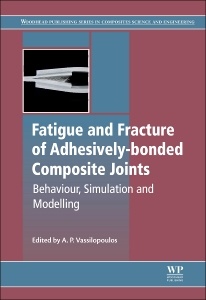Description
Fatigue and Fracture of Adhesively-Bonded Composite Joints
Coordinator: Vassilopoulos Anastasios P.
Language: English
Subjects for Fatigue and Fracture of Adhesively-Bonded Composite Joints:
Keywords
Adherend shaping; Adhesive; Adhesive joints; Adhesive properties; Adhesive thickness; Adhesively-bonded joints; Asymmetric DCB; Asymmetric MMB; Bayesian inference; Block loading; Bonded joints; Carbon fibre-reinforced composites; Cohesive elements; Cohesive laws for mixed-mode fatigue; Cohesive zone model; Compliance monitoring; Composite joints; Composite properties; Crack growth rate; Creep-fatigue interaction; Cyclic cohesive zone; Cyclic delamination modeling; DCB; Damage prognosis; Experimental testing; Fatigue; Fatigue and fracture mechanics; Fatigue crack growth; Fatigue crack propagation; Fatigue delamination simulation; Fatigue fracture; Fatigue lifetime modelling; Fiber bridging; Fillet; Finite element; Finite element analysis; Fractography; Fracture; Fracture mechanics; Glass fibers; Hybrid joints; Interlaminar mixed-mode fatigue; Lap joints; Linear elastic fracture mechanics; Load sequence; Mixed mode loading; Mixed-mode delamination; Mixed-mode fatigue of composites; Mode I; Mode partition; Onset; Overlap; Probabilistic debonding detection and quantification; Probabilistic debonding propagation; Pultruded GFRP composites; Remaining fatigue life; Repair techniques; Residual strength; Simulation; Standards; Stepped-lap joints; Stress ratio; Test procedures; Variable amplitude fatigue; Variable amplitude loading; Virtual crack closure
552 p. · 15x22.8 cm · Hardback
Description
/li>Contents
/li>Readership
/li>Biography
/li>Comment
/li>
It is commonly accepted that the majority of engineering failures happen due to fatigue or fracture phenomena. Adhesive bonding is a prevailing joining technique, widely used for critical connections in composite structures. However, the lack of knowledge regarding fatigue and fracture behaviour, and the shortage of tools for credible fatigue design, hinders the potential benefits of adhesively bonded joints. The demand for reliable and safe structures necessitates deep knowledge in this area in order to avoid catastrophic structural failures.
This book reviews recent research in the field of fatigue and fracture of adhesively-bonded composite joints. The first part of the book discusses the experimental investigation of the reliability of adhesively-bonded composite joints, current research on understanding damage mechanisms, fatigue and fracture, durability and ageing as well as implications for design. The second part of the book covers the modelling of bond performance and failure mechanisms in different loading conditions.
Part I Introduction to fatigue and fracture of adhesively-bonded composite joints
1. Investigating the performance of adhesively-bonded composite joints: standards, test protocols and experimental design
2. Joint design for adhesively-bonded composite joints
3. Understanding fatigue loading conditions in adhesively-bonded composite joints
Part II Fatigue and fracture behaviour of adhesively-bonded composite joints
4. Mode 1 fatigue and fracture behaviour of adhesively-bonded carbon fibre-reinforced polymer (CFRP) composite joints
5. Mode I fatigue behaviour and fracture of adhesively-bonded fibre-reinforced polymer
6. Mode I fatigue and fracture behaviour of adhesively-bonded pultruded glass fibre-reinforced polymer (GFRP) composite joints
7. Mixed mode fracture and fatigue behaviour of adhesively-bonded composite joints
8. Fatigue and fracture behaviour of adhesively-bonded composite structural joints
9. Block and variable amplitude fatigue and fracture behaviour of adhesively-bonded composite joints
10. Durability and residual strength of adhesively-bonded composite joints: the case of F/A-18 A-D wing-root stepped-lap joint
Part III Modelling fatigue and fracture behaviour
11. Simulating mode 1 fatigue crack propagation in adhesively-bonded composite joints
12. Simulating the effect of fibre bridging and asymmetry on the fracture behaviour of adhesively-bonded composite joints
13. Simulation of mixed mode fatigue delamination/debonding in adhesively-bonded composite joints
Researchers in the aerospace, mechanical and civil engineering domains. Also graduate (PhD) students working within the field.
- A detailed reference work for researchers in aerospace and engineering
- Expert coverage of different adhesively bonded composite joint structures
- An overview of joint failure




